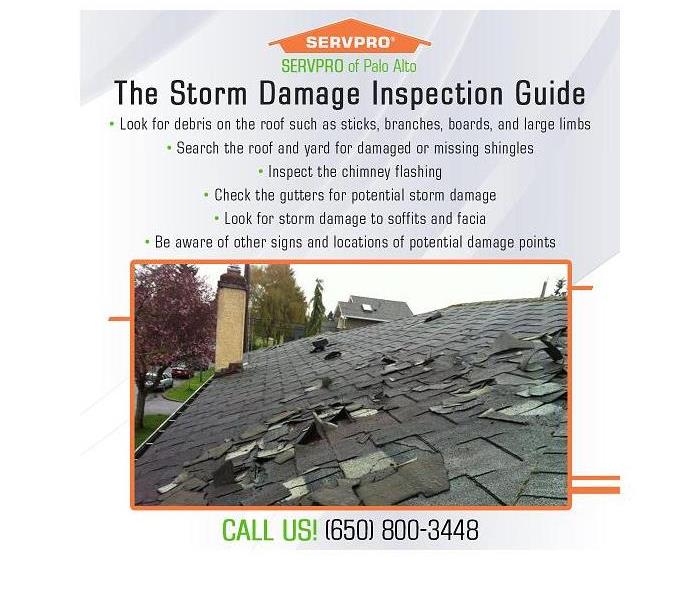A Guide to Inspecting Atherton, CA, Homes for Storm Damage after Severe Weather
11/21/2021 (Permalink)
Blog Summary: SERVPRO of Palo Alto shares five tips for identifying storm damage to homes in Redwood City and the surrounding communities.
The team of professionals at SERVPRO of Palo Alto is experienced and skilled at helping Atherton, CA, residents and business owners recover from storm damage. Technicians quickly and effectively implement structural drying techniques that halt any advanced secondary damage and prepare the site for the restoration and cleaning process.
When a thunderstorm or other severe weather strikes a home or business, storm damage, even on a small scale, can cause expensive long-term issues when repairs are not made quickly.
Causes of storm damage include large hailstones, heavy rain, flooding, high winds, and even lightning. A quick inspection and assessment of the home can reveal any damage that can be immediately repaired. Here is a checklist of potential damage points in the event of strong storms and severe weather. The weather event may appear to be minimal. Yet, minor damage, if left unresolved, can cause much damage over time.
The Storm Damage Inspection Guide
- Look for debris on the roof such as sticks, branches, boards, and large limbs.
A wind gust of 50 to 75 miles per hour is not unusual in turbulent weather, and updrafts can carry light furniture, toys, and garbage cans high into the air. Impact on a roof or awning can damage shingles and puncture the roof. The sharp point of a broken limb can create a sizable hole in the roof. The wind may then reposition the branch so that it does not appear that the impact with the roof caused any damage. A two-inch hole at the top of the roof may not be detectable from the ground.
- Search the roof and yard for damaged or missing shingles.
Shingles scattered around the yard or littering the shrubbery are a telltale sign of roof damage and a possible water intrusion. Check the shingle style and color to ensure any detached shingles are not from a neighbor’s roof but are from the roof being inspected.
According to the International Institute of Building Enclosure Consultants (IIBEC), wind can lift shingles, reducing their overall ability to protect the roof and prevent water damage. The IIBEC reports, “‘Wind-lifted’ or ‘wind-damaged’ shingles are not always visually apparent but are damaging to the roof. Any shingle with inadequate adhesion is a ‘wind-lifted’ or ‘wind-damaged’ shingle. Empirical (visual) tests can easily demonstrate the strength reduction of a shingle after a storm event.”
When shingles have been compromised by high winds and suffer wind-lifting, their ability to prevent water damage is reduced. If high winds were present in the severe weather, the best strategy is to call in a reputable roofing contractor to inspect the roof.
- Inspect the chimney flashing.
When the metal flashing around the chimney comes loose or becomes cracked during a storm, water can leak inside the attic at the contact point with the chimney. The moisture intrusion can cause structural damage. Mold grows well in a warm, moist attic.
- Check the gutters for potential storm damage.
If rainfall is heavy, gutters may not be able to efficiently evacuate the water from the roof. A gutter filled with water is very heavy and can pull away from the house. This situation allows water to run between the roof and the gutter, causing water damage to the eaves of the home.
- Look for storm damage to soffits and fascia.
Examine soffits and fascia for warping, separation, and rot. If damage is discovered, address the issues immediately. Moisture can work its way into the attic and walls, causing decay, mildew, and mold.
- Be aware of other signs and locations of potential damage points.
- Pools of water in the crawl space
- Broken window panes and peeling or bubbling paint around windows
- Punctures, dents, and gaps in exterior walls
- Water stains on interior and exterior walls
- Outbuildings and fencing
When to Contact a Property Damage Restoration Company for Storm Damage
The best time to contact a property damage restoration company for storm damage is before the damage occurs. By prequalifying a restoration company before the disaster occurs, only one call is needed to have a crew on-site in about an hour to begin the inspection, assessment, cleanup, and restoration process.
For more information about Atherton, CA, storm damage restoration services, contact the SERVPRO of Palo Alto office by phone at (650) 800-3448. Staff can also be reached by email at office@SERVPROpaloalto.com



 24/7 Emergency Service
24/7 Emergency Service
